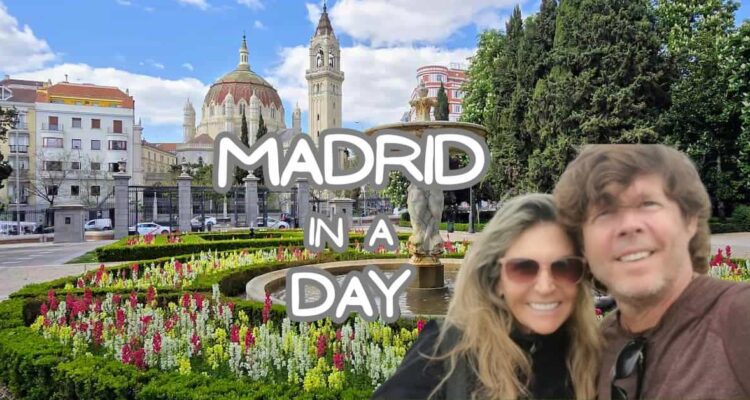Madrid in a Day, can it really be done? The answer is a resounding yes. Of course this super walkable and lively city deserves a lot more time. However, if you just have one day in Madrid, then let’s maximize it and pack as much as possible into this fabulous city visit.
I have spent quite a bit of time here wandering, learning and exploring. And with that knowledge, plus the help of local guides and other locals who have provided so much guidance to us during our visits here, we think we have assembled the perfect guide for someone to spend one day in Madrid.
Let’s dive in as we will be sharing the most iconic sights, best places to venture (with some options based on preferences), eateries and accommodations for your perfect one day in Madrid.
Morning – Traditional Breakfast and Top Sights
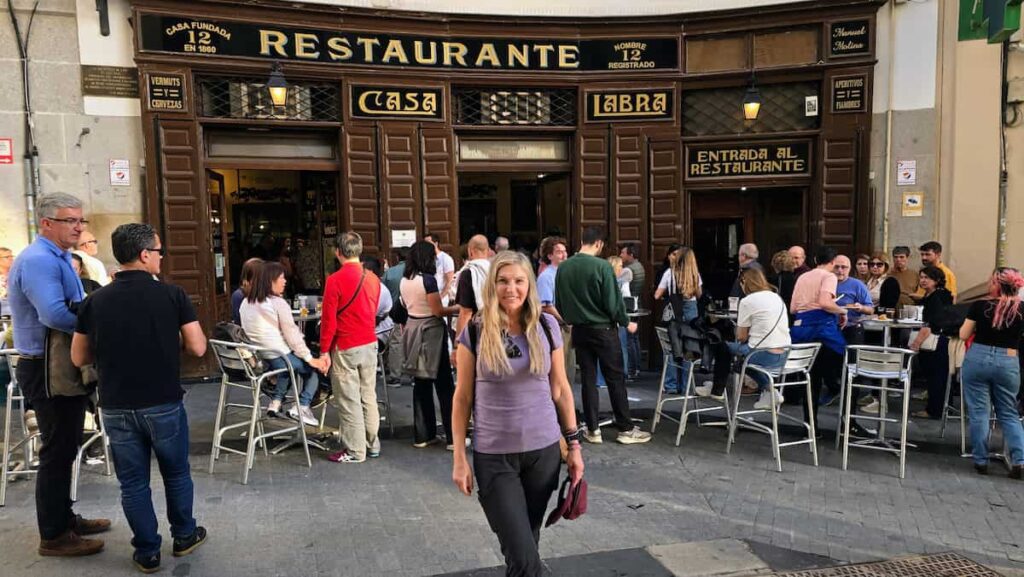
Start your day the traditional Spanish way with a coffee and a chocolate churro from the Chocolatería San Ginés. This place is a local institution as it was founded in 1894 and has served millions of great coffees and churros to locals and tourists alike.
If you want something a bit more substantial for your breakfast, then make your way to Matilda Cafe in the Barrio de Las Letras. This is a cozy place with limited seating both inside and outside. Try their famous tortillas (Spanish omelette) and a good coffee.
Puerta Del Sol
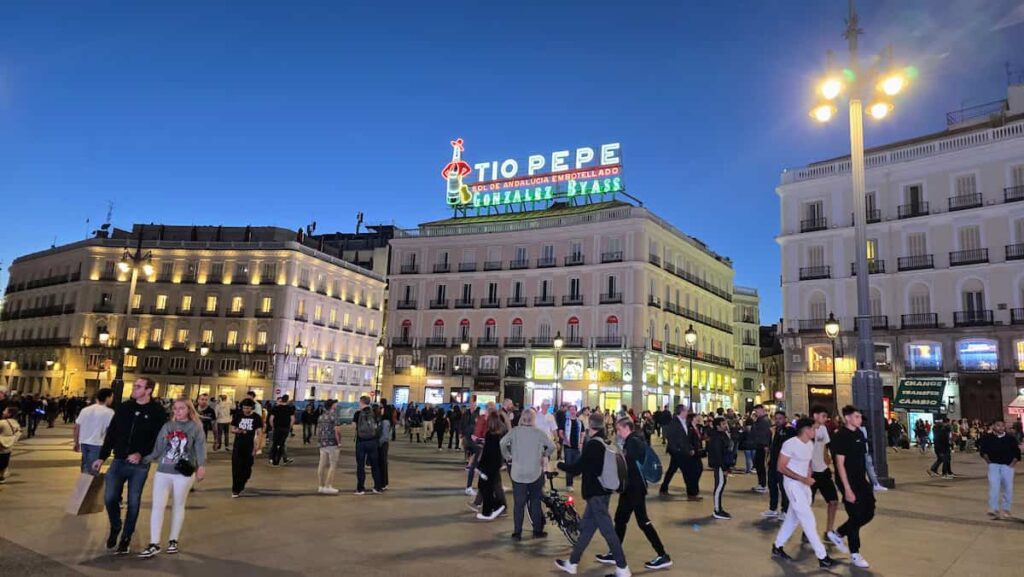
Now that you are properly fueled for the morning, head over to the top sights that every visitor (even those visiting Madrid in a day) have to see. We will enter Madrid’s historic center through the famous Puerta del Sol . This plaza is from where all routes get measured in Spain known as Kilometer Zero.
It’s a lively plaza with well known landmarks like the Bear and the Strawberry Tree statue and the Royal House of the Post Office and it’s clock. This clock has been ringing in the New Year since 1866 and marks the eating of the 12 grapes tradition.
This tradition was started in 1909 when wine producers had too many grapes and needed to promote the consumption of them. So, they spread a legendary rumor that in order to have good luck for the coming 12 months, at the stroke of midnight on New Year’s Eve, people have to eat twelve grapes. One with each bell chime, making a wish for each month to ensure good luck in the coming year.
Plaza Mayor
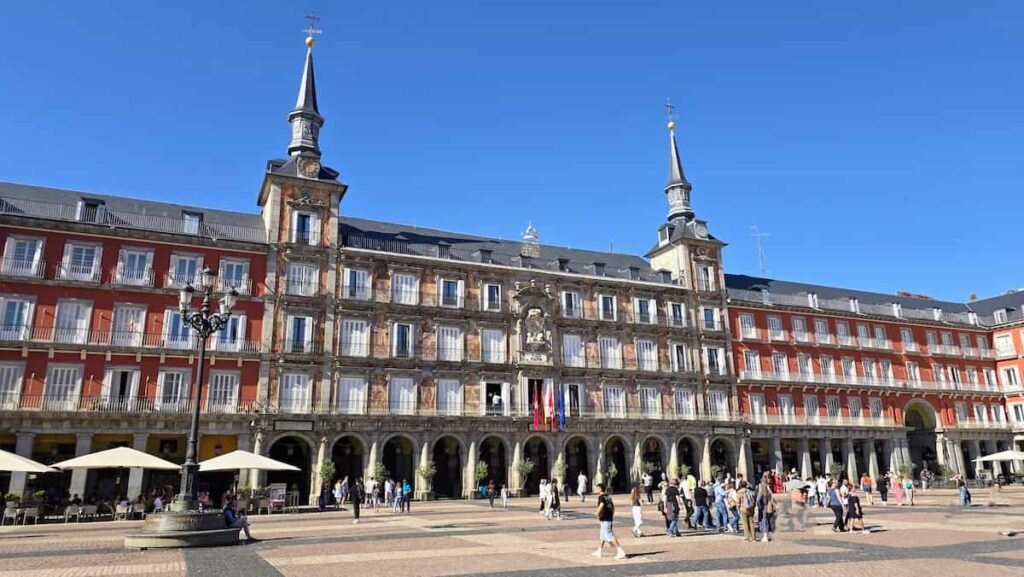
From Puerta del Sol, we will head west to the Plaza Mayor, a grand square with uniform, impressive architecture of residential buildings with balconies overlooking the expansive cobblestone plaza. This plaza dates back to the 16th century and was once the site of bullfights, coronations, and public executions. Today it hosts markets, festivals and has numerous cafes and restaurants.
Market San Miguel
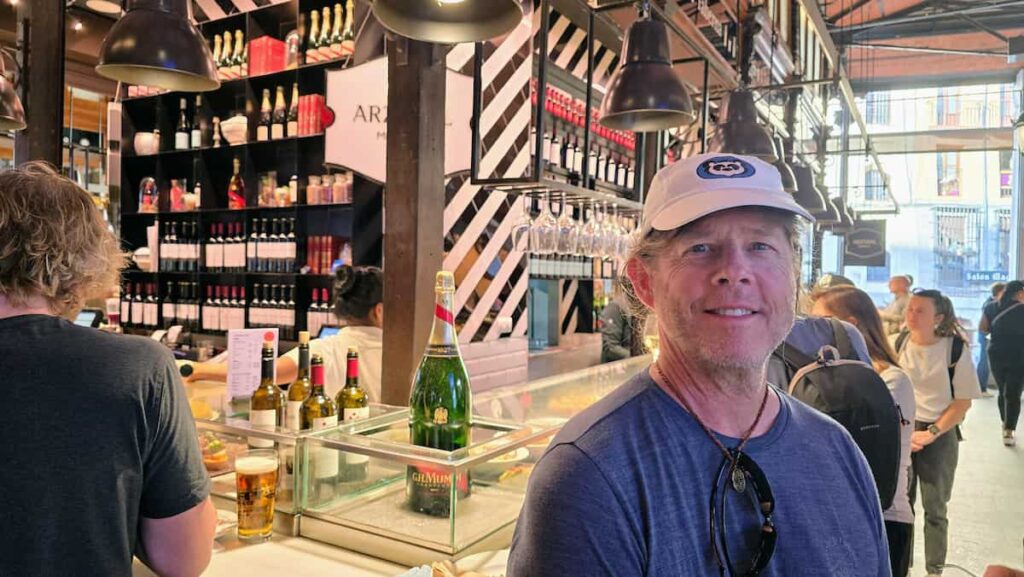
Heading west from the Plaza Mayor and within a couple of minutes we will reach the Mercado de San Miguel. This historic covered market with it’s interesting iron structure was originally built in 1916. Today, San Miguel is no longer a traditional fresh produce market but a gourmet tapas paradise.
Here, you can wander through over 30 stalls offering a diverse range of high-quality Spanish delicacies, from fresh seafood and Iberian ham to artisanal cheeses, olives, and delectable pastries. It’s a bit of a tourist trap, but is worth a pass through with your eyes if not your stomach.
However, if you must stop for a sample, then go for it, but don’t indulge too much as we have so much more to see!
La Tienda de Los Deseos
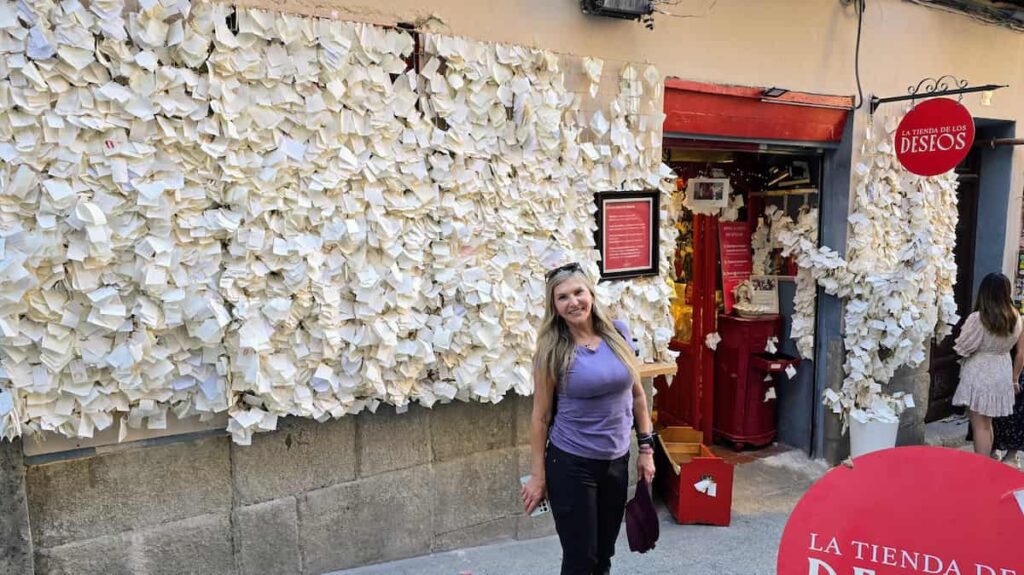
On your way, stop by La Tienda de los Deseos – the store of wishes. At the door, grab a piece of paper, a string and a pen. Write your wish, tie a string around the piece of paper and tie it to the wall. Once you are done, ring the bell to let the universe know that you have written the wish.
It is a lovely place and reading some of the wishes – especially from children hoping that their sibling or friend recovers from cancer or another illness really provide perspective and awe.
Cathedral’s Viewpoint & Royal Palace

From Plaza Mayor, we will walk over to the Cathedral’s Viewpoint which is a small hill looking over the relatively new Cathedral and the Royal Palace of Madrid. Beyond the Cathedral and Palace you will see a huge green space which is a fantastic park which we urge you to explore if you are spending more than one day in Madrid.
While a one hour tour of the Royal Palace on this one day in Madrid itinerary is possible, even a stroll around its exterior offers impressive views. If you do choose to go into the Palace we highly recommend pre-purchasing tickets in advance through the official Palace website.
Templo de Debod
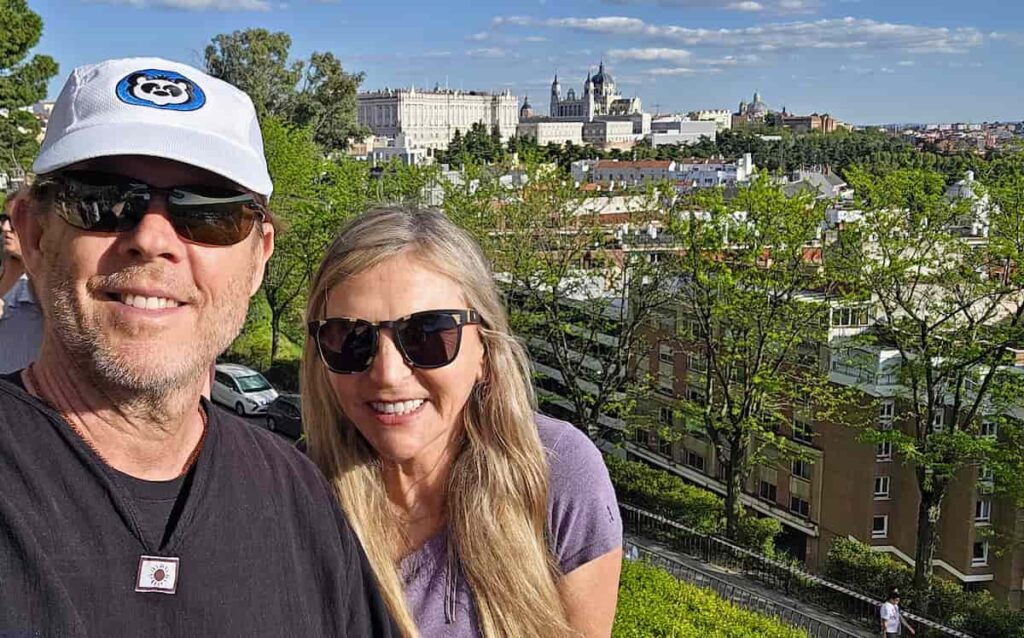
A short distance to the north of the Palace is Templo de Debod. This 2nd century BC Egyptian temple and museum were moved from Aswan Egypt and rebuilt on this hill in 1968. It offers panoramic views of Madrid any time of day or night (especially at sunset).
There is another place that we have in store for your sunset during your one day in Madrid itinerary. However, if you are here longer, then make sure to come here for one of those sunsets.
Timing: If you start at 08:00 and include the Royal Palace you should be entering the Royal Palace at it’s opening hour of 10:00).
Midday – El Prado and Lunch

The Prado Museum is one of the top art galleries in the world housing an extensive collection of Spanish and European masters. It is one of the best places to visit even if you are spending only one day in Madrid.
Because we are showing you as much as possible of Madrid in a day, we want to get you through the museum as efficiently as possible highlighting the top 10 art pieces with a proper flow through the rooms and their locations (although art pieces do get moved, so ask at information if you can’t find something).
You should be able to see all of these top 10 pieces in 1 hour:
El Prado – Top 10 Must See Art Pieces
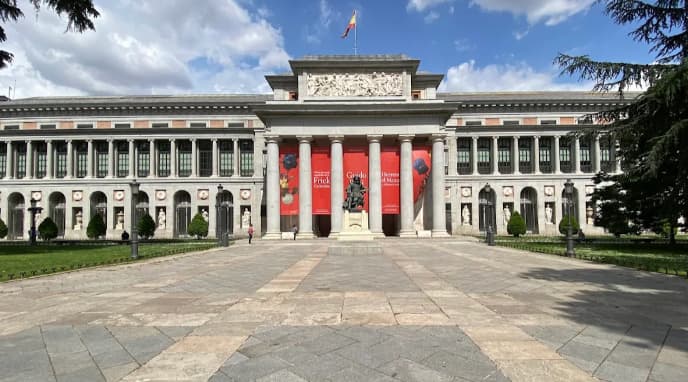
“Las Meninas” by Diego Velázquez (1656) – Room 12: This complex masterpiece portrays the Infanta Margarita and her entourage within Velázquez’s studio, including the artist himself, creating an interesting exploration of perspective, reality, and the role of the viewer.
“The Nobleman with his Hand on his Chest” by El Greco (c. 1580) – Room 9B: This striking portrait shows El Greco’s distinctive style with its elongated figure, intense gaze, and somber color palette, conveying a sense of dignity and inner reflection characteristic of Spanish Renaissance portraits. However, the man’s identity remains a captivating mystery.
“The Garden of Earthly Delights” by Hieronymus Bosch (c. 1490-1510) – Room 56A: This fantastical 3 panel painting presents a vivid, symbolic journey from paradise to earthly pleasures and finally to hell, filled with intricate details and imagery that continues to fascinate and provoke interpretation. I find this piece very haunting.
“The Third of May 1808” by Francisco de Goya (1814) – Room 64: A powerful and moving depiction of the execution of Spanish civilians by French soldiers, this painting stands as a stark condemnation of war’s brutality and a symbol of resistance against oppression.
“Saturn Devouring His Son” by Francisco de Goya (c. 1819-1823) – Room 67: One of Goya’s disturbing “Black Paintings,” this work depicts the Titan Cronus (Saturn) consuming one of his children, embodying themes of fear, power, and the destructive nature of time.
“The Three Graces” by Peter Paul Rubens (c. 1639): This lush and sensual painting celebrates female beauty, depicting the mythological Graces in a harmonious and dynamic composition characteristic of Rubens’s Baroque style.
“The Descent from the Cross” by Rogier van der Weyden (c. 1435) – Room 58: This emotionally intense and meticulously detailed altarpiece captures the profound grief and solemnity of Christ’s removal from the cross, showcasing van der Weyden’s mastery of conveying human emotion.
“Self-Portrait” by Albrecht Dürer (1498) – Room 55B: This early self-portrait showcases Dürer’s budding talent and self-awareness as an artist, presenting him in fashionable attire and with a confident gaze, reflecting the Renaissance emphasis on the individual.
“David and Goliath” by Caravaggio (c. 1599-1600) – Room 8B: This dramatic painting captures the pivotal moment of David’s triumph over the giant Goliath, marked by Caravaggio’s signature use of chiaroscuro (use of light and shadow) to heighten the intensity and realism of the scene.
“The Annunciation” by Fra Angelico (c. 1430-1432) – Room 49: This serene and luminous painting depicts the Archangel Gabriel announcing to the Virgin Mary that she will conceive Jesus, embodying the spiritual grace and delicate beauty of the Early Italian Renaissance.
Tip: Start your visit at the Goya entrance to access these rooms efficiently.
Timing: If you had included the tour of the Royal Palace, you will be arriving at the Prado at approximately 11:30. And if you chose to walk around it, you will find yourself at the Prado at around 10:30.
Lunch Recommendations
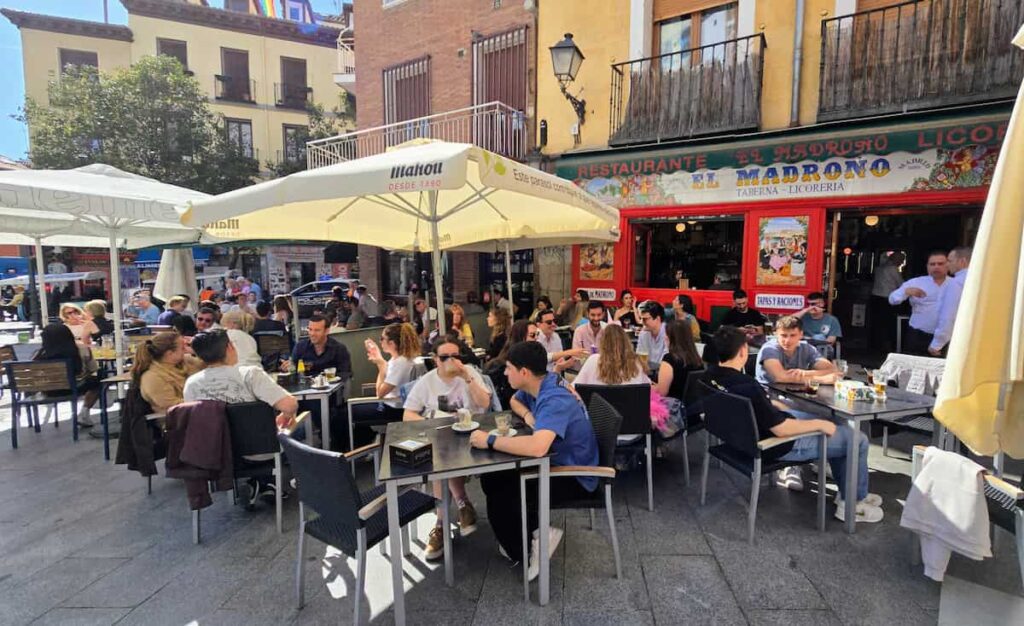
After your exploration of the center of town and the Prado you should be sufficiently hungry to enjoy a great traditional Madrid lunch. Here are our top 2 suggestions. One is a quick grab and go lunch to enjoy in the park (your next stop) and the other is a more traditional sit down lunch.
If you had chosen to visit the Royal Palace inside, we suggest the quicker grab and go lunch that you can have while strolling El Retiro Park. Our suggestion, is to pre-order the food if you want to grab it to go to El Retiro about 20 minutes before you are done in the museum.
Otherwise, take up to an hour for a traditional lunch. If you did not visit Matilda Cafe in the Barrio de Las Letras for breakfast, then we highly recommend it for lunch time. It is closed Mondays and Tuesdays though.
Matilda’s is a 7 minute walk from the Prado through a pretty greenbelt of P. del Prado. Have a quick croissant with Ham and Cheese or the Tortilla with Potatoes and Eggs.
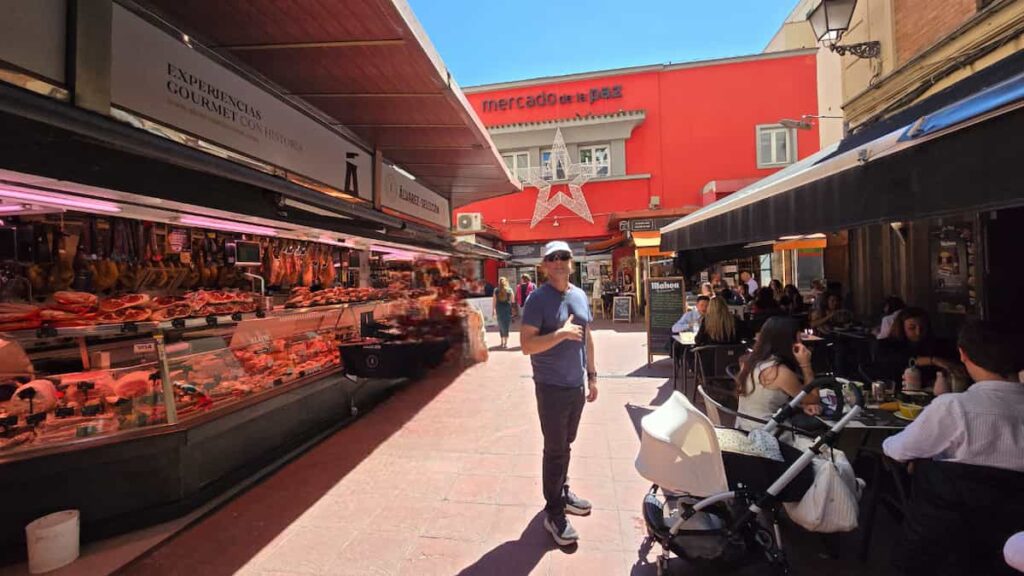
Here are a few other options for your lunch during your one day in Madrid itinerary:
Brisket Restaurante has a variety of burger options and of course brisket that locals adore because it is very juicy and prepared in truffle oil.
From the front doors of the Prado Museum make a right and an immediate left on Calle de Casado del Alisal. Then make your first left on Calle de Moreto. The Brisket will be on your right after a 3 minute walk from the museum.
Taberna Jimmy’s offers either a quick sit down lunch or one to go. Try the chickpea and sausage stew or the menu of the day.
From the front doors of the Prado Museum make a left and an immediate right onto Calle de la Academia. Jimmy’s is on the left just 3 minutes from the museum.
Afternoon El Retiro Park and Neighborhood Walks
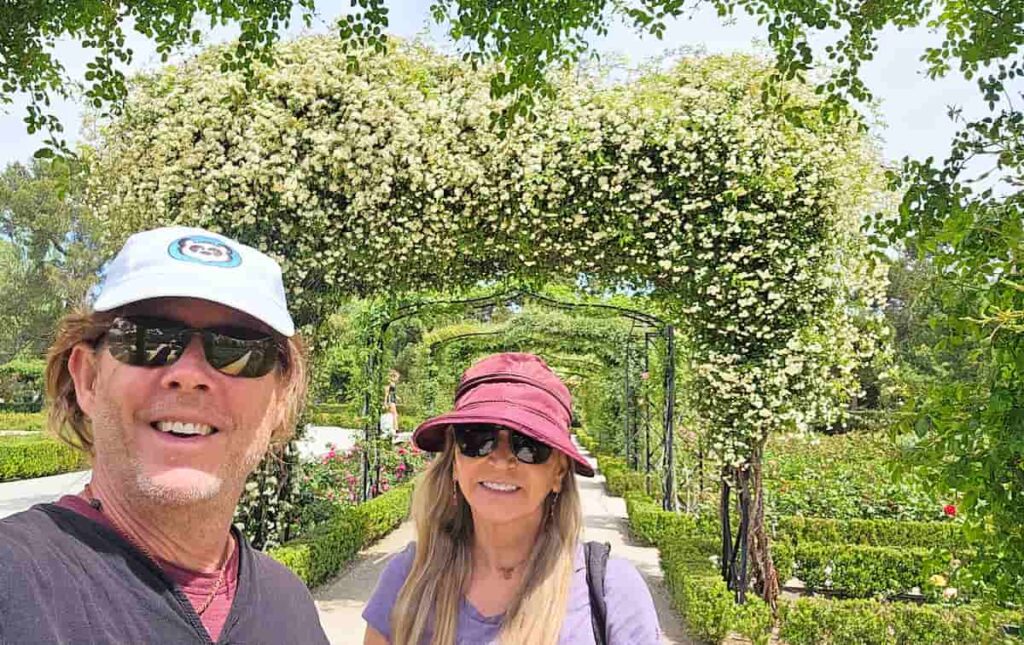
In the afternoon we will focus on visiting the El Retiro Park – a UNESCO world heritage site and 2 lovely neighborhoods. An upscale one called Salamanca which is just north of El Retiro Park and another where famous writers once lived called the Literary Quarter.
El Retiro Park
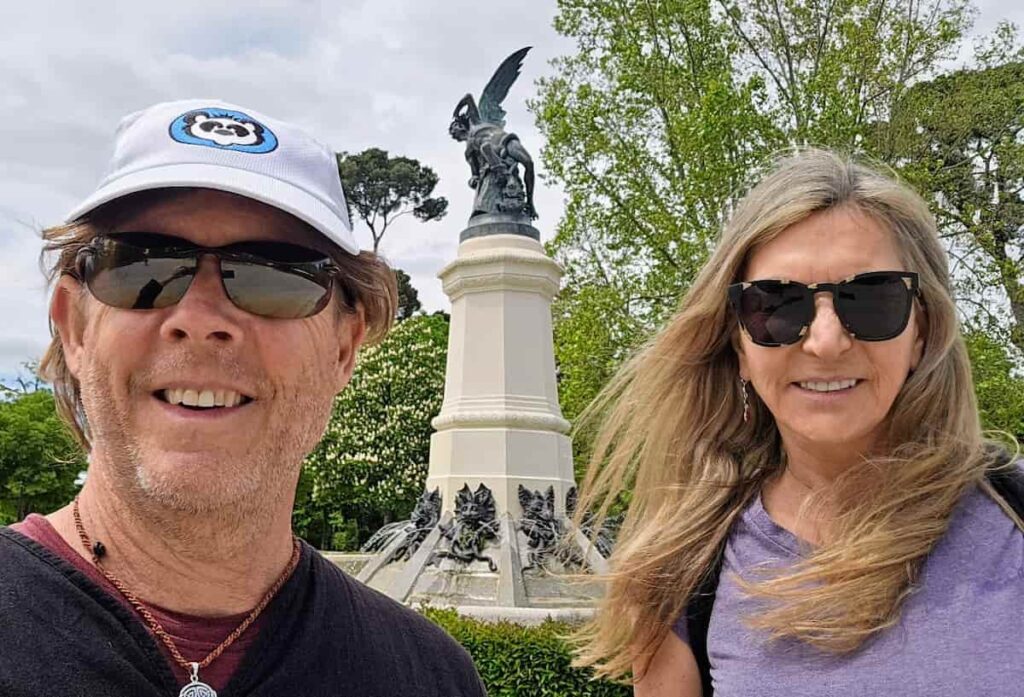
El Retiro Park since the 17th century was the private retreat of the Spanish Monarchy and opened to the public in the late 19th century to become the beloved green oasis in the heart of Madrid. As you pass through the gates of El Retiro from Cale de Alfonso XII you will pass by many bookshop stalls that have been there since 1925 selling second hand books and records.
As you continue on this wide peaceful walking street, you will see the Fountain of the Fallen Angel which has an interesting legend tied to its altitude: it sits at exactly 666 meters above sea level. This coincidental number, associated with the biblical “number of the beast,” has fueled local lore, adding a layer of dark mystique to the monument dedicated to Lucifer’s fall.
A few minutes from the fountain you will reach the gorgeous Rosaleda Rose Garden (make sure to smell the roses – some of them smell like divine perfume)! From there head north to the grand Crystal Palace (currently under renovations) and its reflecting pond with swans and ducks. As you continue north you will find a boating lake with a large Monument to Alfonso XII.
Salamanca
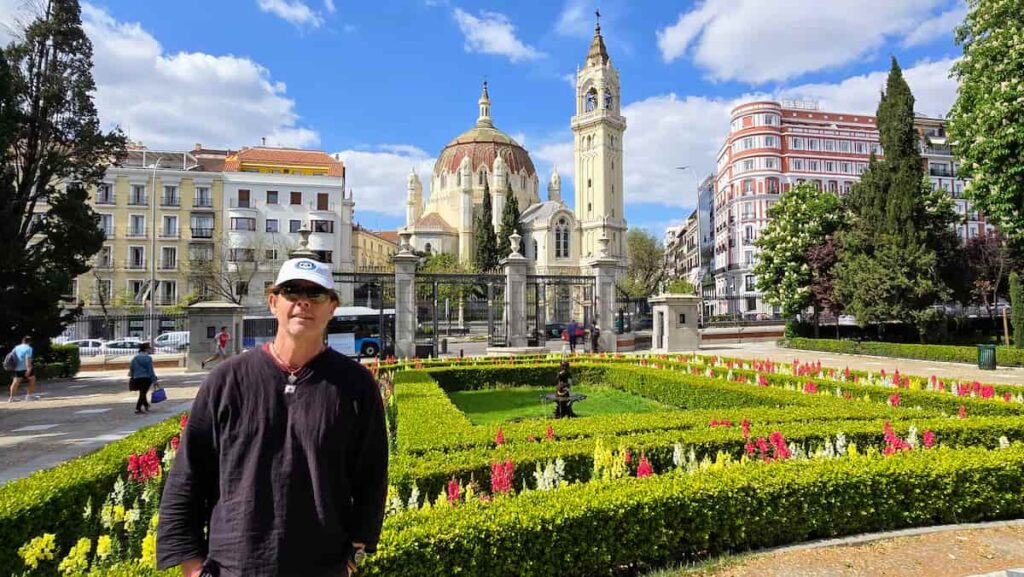
The Salamanca district, developed in the 19th century, is loved for its grid-like streets, upscale boutiques, and stately architecture. It encompasses several sub-neighborhoods, including Recoletos, Goya, and Castellana, each offering a unique charm.
Walking Route through the Salamanca Neighborhood
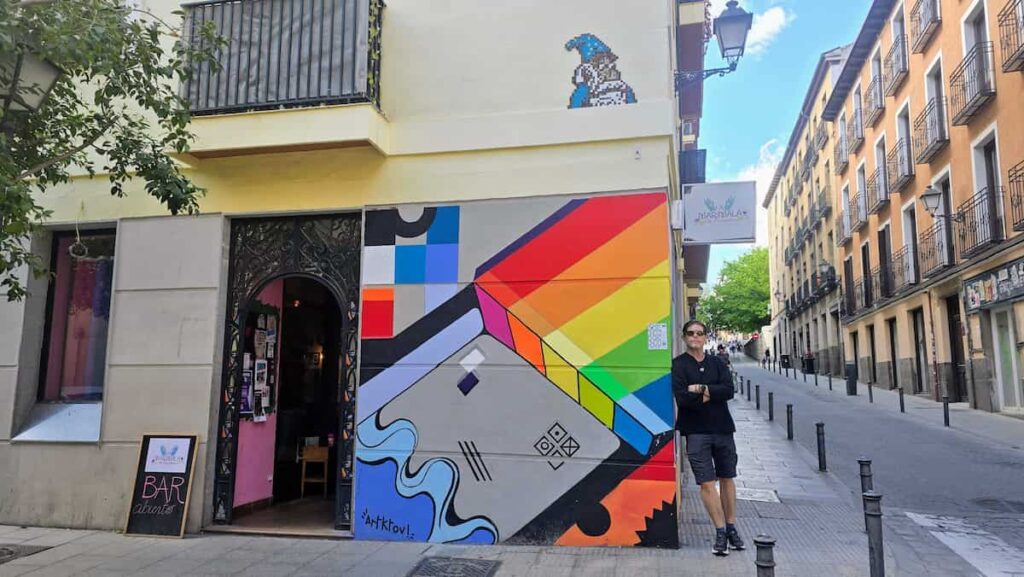
Exit El Retiro Park at the northern gate near Puerta de Alcalá and continue on this route:
Calle de Serrano: Begin your walk on this iconic avenue, known for luxury shopping and elegant facades. It’s often compared to New York’s Fifth Avenue.
Calle de Ortega y Gasset: Turn onto this street to explore high-end boutiques and enjoy the sophisticated atmosphere.
Calle de Velázquez: Continue your stroll along this parallel street, lined with art galleries and classic Madrid architecture.
Calle de Goya: Head west on this lively street, offering a mix of shopping and local eateries.
Recommended Stop: Círculo Coffee Studio
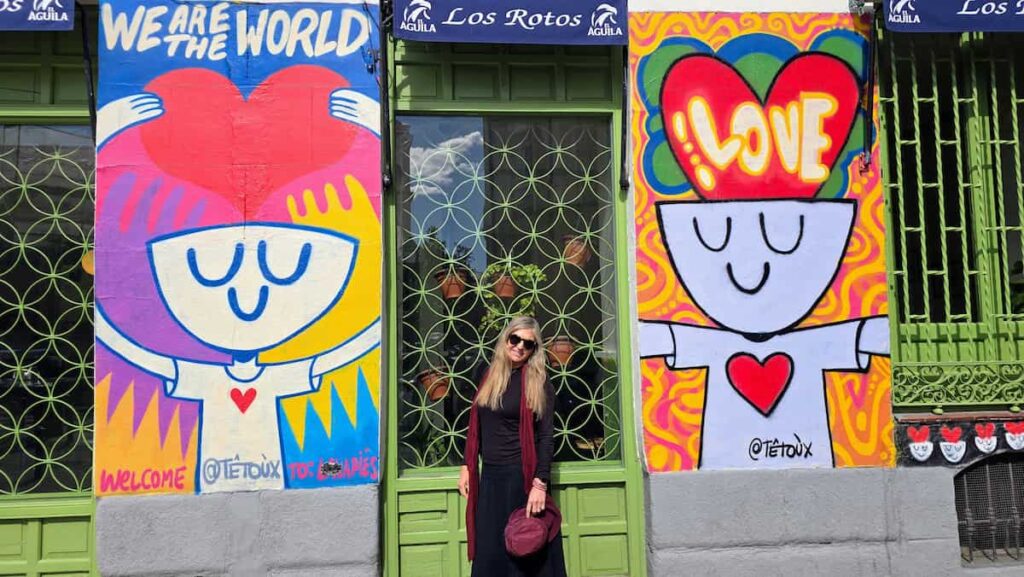
Located on Calle de las Infantes, Circulo Coffee Studio is a great place to grab a pick me up coffee as they roast their own ethically sourced beans.
Literary Quarter
The Literary Quarter, or Barrio de las Letras, was home to some of Spain’s most famous writers during the 16th and 17th centuries, including Miguel de Cervantes and Lope de Vega. The area is rich in history, with streets named after literary figures and quotes embedded in the pavement.
Walking Route Through the Literary Quarter
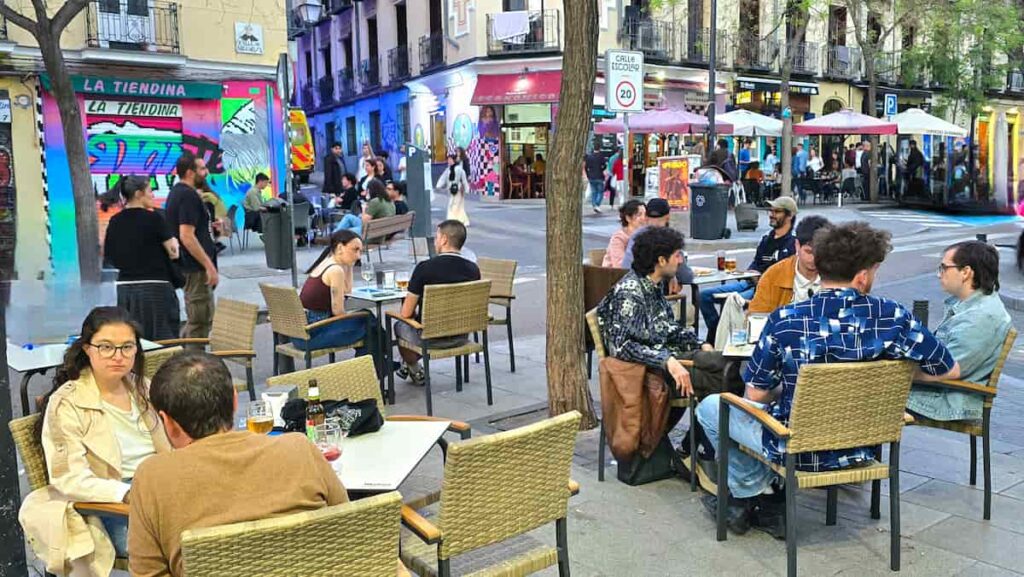
From Calle de Goya, make your way south towards Calle de Alcalá, then proceed to the Literary Quarter and these streets:
Calle de las Huertas: Start your exploration on this happening street, known for its literary inscriptions and lively atmosphere.
Calle de Cervantes: Visit the Lope de Vega House Museum here, offering insights into the writer’s life.
Calle de Lope de Vega: This street complements the previous, highlighting the area’s literary significance.
Calle del León: A charming street with historical buildings and quaint shops.
Plaza de Santa Ana: Conclude your walk at this busy square, surrounded by theaters and cafes.
Reina Sofia Museum (Option)
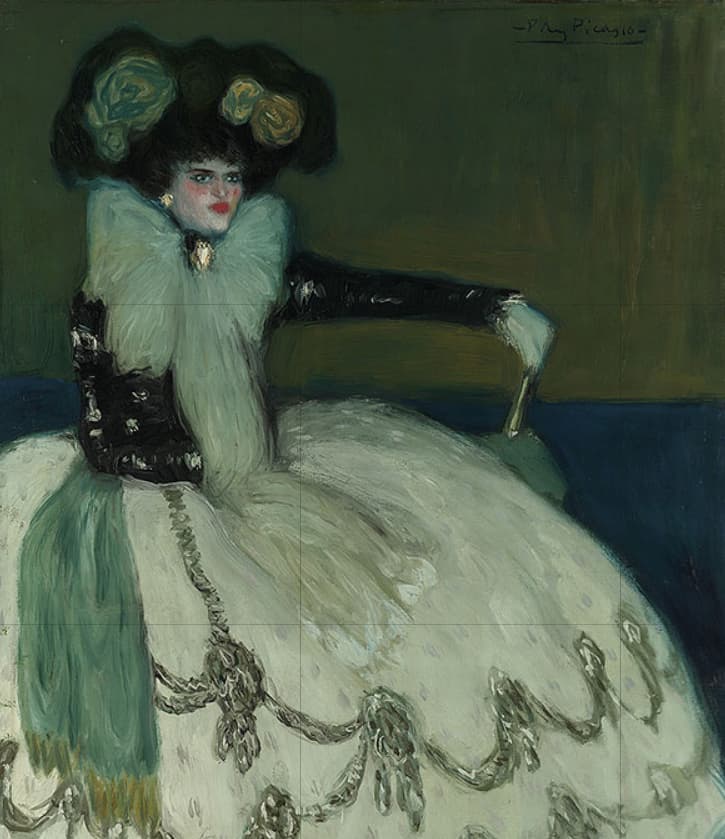
If you decided to skip the inside tour of the Royal Palace, then you will still have time to visit the Reina Sofia Museum. This is Spain’s national museum of 20th-century art, most famously home to Picasso’s masterpiece Guernica. Its extensive collection showcases the evolution of modern and contemporary Spanish art, featuring prominent artists like Dalí and Miró, alongside international figures.
In order for you to see the best of Madrid in a day, here are 10 best pieces of art to see at the Reina Sofia Museum:
“Guernica” by Pablo Picasso 1937 – Room 205.10
Picasso’s monumental and deeply moving response to the bombing of Guernica during the Spanish Civil War, a powerful anti-war symbol rendered in stark black, white, and grey.
“The Painter and His Model” by Pablo Picasso 1928 – Room 205.10 A work from Picasso’s Surrealist-influenced period, depicting the artist and his muse in a fragmented and dreamlike manner, exploring themes of creation and desire.
“Woman in Blue” by Pablo Picasso 1901 – Room 201.02
Painted during Picasso’s Blue Period, this melancholic portrait features a solitary figure rendered in predominantly blue tones, evoking themes of loneliness and introspection.
“The Great Masturbator” by Salvador Dalí 1925– Room 205.13
A key Surrealist painting featuring biomorphic (life like shapes) and unsettling imagery, exploring themes of sexuality, fear, and the subconscious, with a prominent grasshopper and a figure often interpreted as a self-portrait.
“Figure at the Window” by Salvador Dalí 1925 – Room 205.06
An earlier work by Dalí, predating his fully developed Surrealist style, depicting his sister Ana María looking out a window in a serene and somewhat melancholic scene.
“Portrait II” by Joan Miró 1925– Room 205.09
A work from Miró’s early, more figurative period before his signature abstract language fully developed, showing a whimsical and slightly distorted human figure with playful elements.
“The Bottle of Rum” by Juan Gris 1914 – Room 204.02
A key example of Synthetic Cubism, taking everyday objects and breaking them down into basic geometric shapes, and then putting them back together in a flat, abstract way, focusing on their core forms and textures rather than realistic representation.
“The Meeting” by Antonio Saura 1956 – Room 205.08 A powerful example of Spanish Informalism, with energetic and sometimes frantic brushstrokes and distorted human figures, often conveying a sense of anguish and the raw human condition in the post-war era.
“Totalizer” by Francis Picabia 1922 – Room 207.02
This is from Picabia’s Dada period, where he uses abstract, often machine-like shapes and forms. These pieces frequently have titles that are ironic, nonsensical, or designed to provoke thought, directly challenging the established rules and serious nature of traditional art by embracing the absurd and illogical.
“Composition” by María Blanchard 1916-1917 – Room 206.02
A significant work within Cubism by a prominent female artist, with fragmented forms, overlapping planes, and a muted yet harmonious color palette.
Tip: Begin your visit at the Sabatini building on the second floor to see “Guernica” and related works, then proceed to the first floor for Dalí and Miró. Keep in mind that artwork does get moved, so you may inquire at information for your favorite pieces of art.
Evening: Sunset Views and a Memorable Dinner
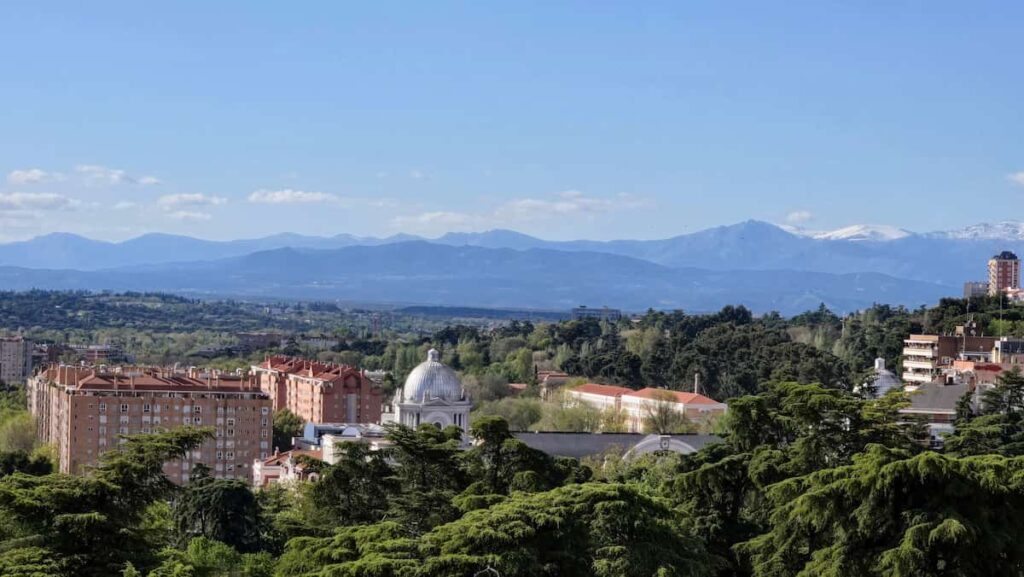
Catch the Sunset at Circulo de Bellas Artes. The €5.50 cost gets you access to this cultural center, including the rooftop terrace plus the art exhibits on the first and basement floors. You can pre-book the ticket or just pay at the door.
Head to the rooftop terrace for panoramic views of Madrid’s skyline, especially breathtaking at sunset. You get a great view of Gran Via, Plaza Cibeles, and even El Retiro Park.
Expect a bit of a line for the elevator 30 minutes before the sunset. Therefore come a few minutes before that time to secure a good place on the rooftop and order some drinks.
Dinner Recommendations
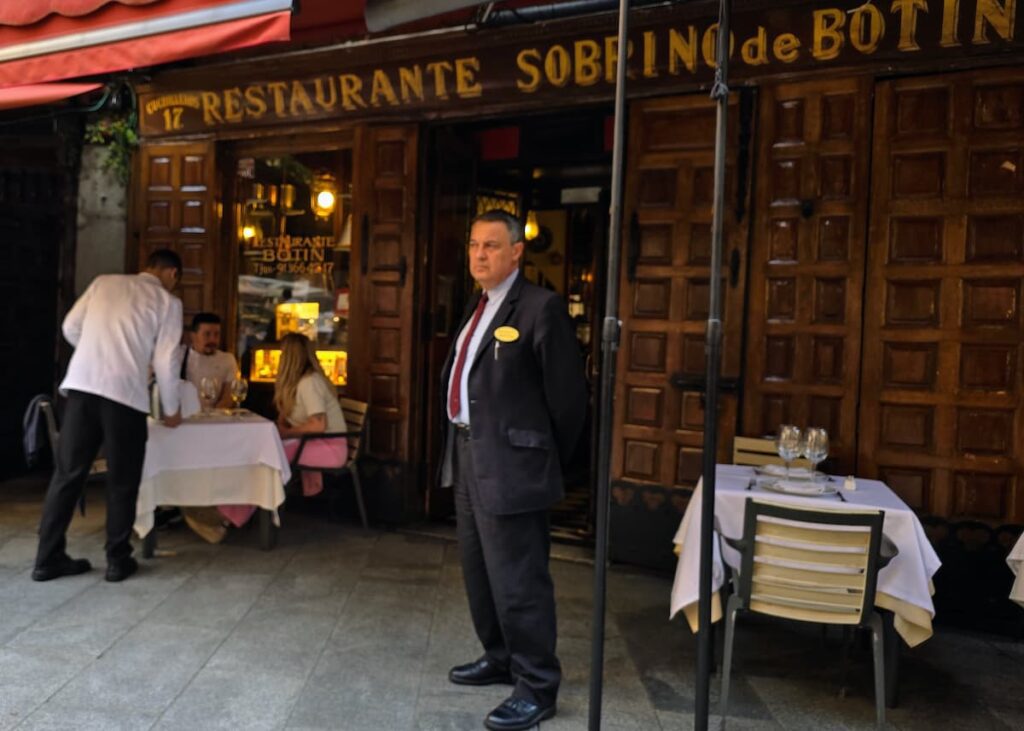
For dinner there are so many options, but remembering that you only have one day in Madrid, here are a few of our top recommendations depending on your budget and food interests:
Sobrino de Botín is considered to be the oldest continuously running restaurant in the world (since 1724). This was Hemingway’s hangout and he mentions the restaurant and its specialty of cochinillo asado (roast suckling pig) in the closing pages of his novel The Sun Also Rises.
Now, if you are a history buff and love Hemingway the experience should be worth it. However, the prices are quite high – so if you are just looking for a great meal at a reasonable price, then our other recommendations should be more in line with what you are looking for.
Taberna Malaspina is an old-fashioned tapas bar popular for strong mojitos & sharing platters of Spanish ham & fried peppers. The bar, located near Puerta del Sol, features a decor with mustard-colored walls, dark wooden beams, and glossy red wine bottles. The prices are reasonable and the atmosphere is lively.

Mad Mad Vegan is a vegan chain restaurant found all over Spain, but we absolutely love it for it’s “buffalo chkn wings” made out of cauliflower and their “calamari” made from oyster mushrooms. They serve Kambucha, their own brewed beer and wine options.
Although there are a few locations in Madrid, our favorite is located in the gritty Lavapies neighborhood filled with street art and a great neighborhood feel. So, if you want a reasonably priced meal with a great local vibe, we highly recommend this eatery whether you are vegan or not.
Hotel for your Madrid in a Day Itinerary
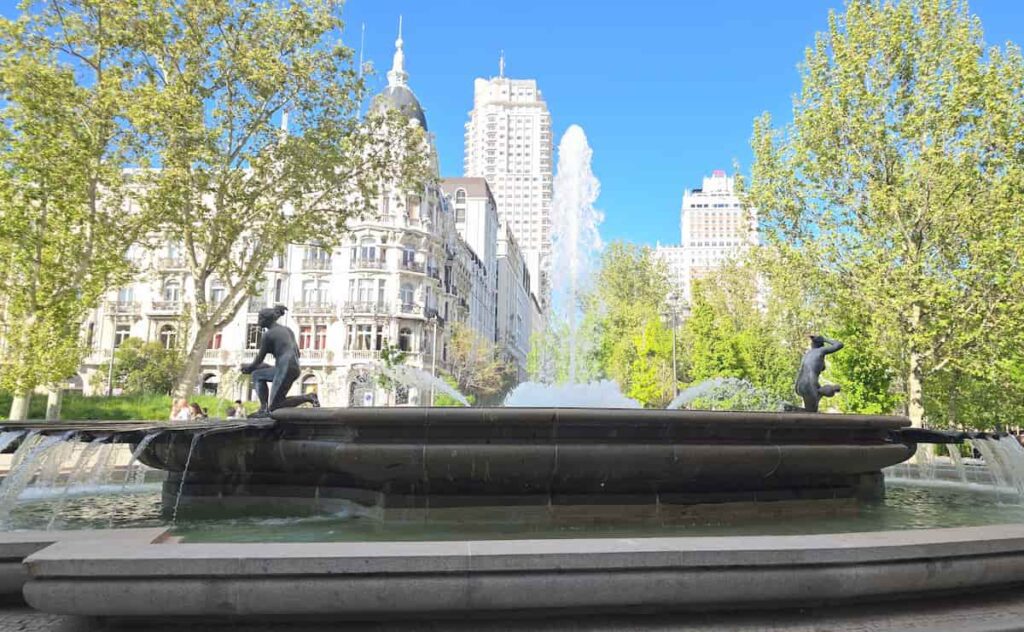
Hotels in this capital can be very expensive. However, since you are spending only one day in Madrid and are packing a lot into this day perhaps the most luxurious hotel is not in order? Here are 3 suggestions with a top budget hostel option and 2 mid range clean and centrally located hotels which will get you into the heart of the city.
With all 3 options you will be steps from where our one day in Madrid itinerary begins. Stashing your backpack or luggage in these places will also be possible, so that you can start your day bright and early.
The Hat Madrid is available through all the platforms but is cheaper through Hostel World. This is a centrally located hostel, just 3 minutes from Plaza Mayor. The rooms are clean and there is a rooftop terrace, laundry and a communal kitchen.
Catalonia Plaza Mayor has comfortable rooms with air conditioning, flat screen TVs, private bathrooms and views of the plaza. It is loved by couples as there is a terrace and a hot tub.
Catalonia Puerta del Sol is another comfortable hotel, set in an 18th century building. It has lovely rooms which have a private bathroom, flat screen TVs, air-conditioning and great views of the Puerta del Sol.
Wrap Up – Madrid What To Do In One Day
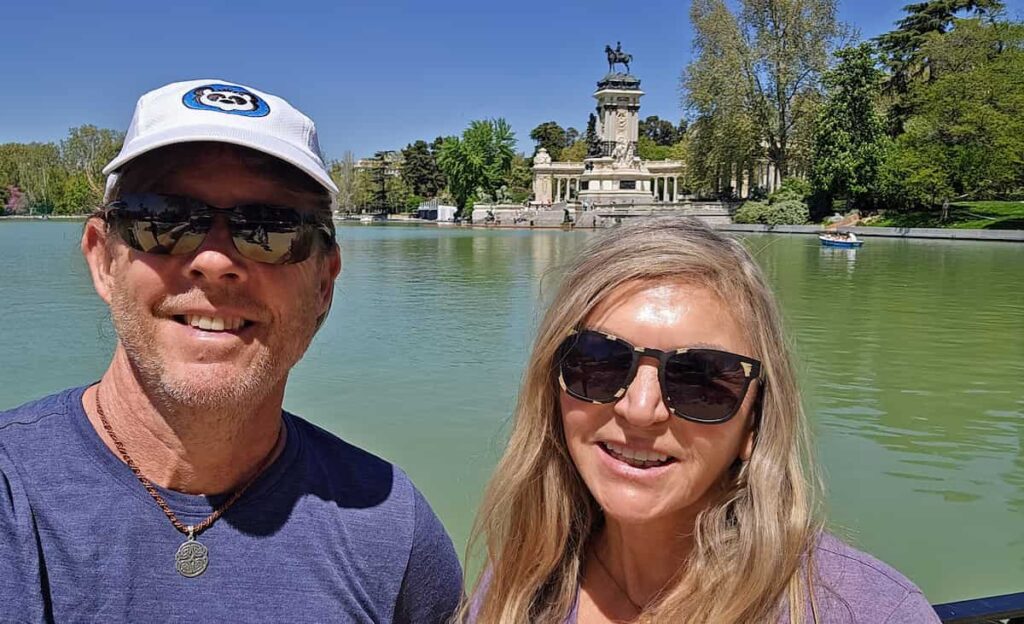
If you want to see Madrid in a day it is certainly possible! Our one day in Madrid itinerary includes the highlights of the city, with the famous Prado, Royal Palace, Reina Sofia Museum, El Retiro park, neighborhood walks, a sunset in a stylish bar overlooking the skyline and dining in some of the most beloved local eateries in the city.
I keep on coming back to this great city and with each visit, discover something new and exciting. So we hope that after your one day in Madrid you will be inspired to come back and explore more in the city and perhaps venture out to enjoy some of the towns that are near Madrid and are great day trips.
Have you been to Madrid or any of the nearby neighborhoods and towns? We would love to hear from you in the comments to learn about what you loved the most. And if you have any questions, please do reach out in the comments as well – we love helping fellow travelers and sharing information.

